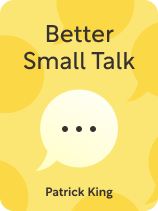

This article is an excerpt from the Shortform book guide to "Better Small Talk" by Patrick King. Shortform has the world's best summaries and analyses of books you should be reading.
Like this article? Sign up for a free trial here.
What types of questions move a conversation in a meaningful direction? How can you appropriately let someone know that you don’t require a response?
Good conversations happen only if the other person feels good when they talk to you. You want to do all you can to ensure your conversation partner feels important and heard and will want to keep engaging with you in the future. One way to do this is by asking the right kinds of questions.
Read on to discover how to use several types of questions to make a conversation interesting and meaningful.
Interesting Conversational Questions
To make space for your conversation partner, social interaction expert Patrick King says that you must master the art of asking questions to make a conversation interesting—questions that prompt meaningful answers. Such questions allow the other person to share thoughts, stories, and ideas that appeal to them, which makes them enjoy the conversation more. Here are some question types you can try out to encourage deep, enjoyable dialogue:
- Open-ended questions. These are questions that demand more than a binary “yes or no” response. “What did you enjoy most about the concert?” is an example of an open-ended question (as opposed to: “Did you enjoy the concert?”).
- Questions that enhance your understanding of the other person’s views. Inquire about why someone feels a certain way or how they developed a belief. Seek to see the world through their eyes.
- Follow-up questions. To drill down more into a topic or sentiment, ask questions that come to mind after hearing their response to your first question. (For instance: “You described the music as solemn; what do you mean by that?”)
- Talk about topics other than the two of you. Your conversations don’t have to just revolve around what you both think, feel, and believe. Talk about other things, like current events, your surroundings, new media you’re consuming, and so on. King notes that this is a great way into someone’s personal thoughts if you don’t feel comfortable asking about those outright.
| Don’t Demand Responses to Your Questions The authors of Difficult Conversations add an important final step to question-asking: Let the other person choose to not answer your question if they don’t want to. Conversations shouldn’t feel like mandatory interviews, and people are often more willing to open up and answer questions if you create an atmosphere in which they feel they can also decline to answer them. You can create such an atmosphere by simply being non-judgmental when someone doesn’t want to answer a question. Ironically, this may make it more likely they’ll open up and answer future questions. While the above questions aren’t inherently probing, some people might perceive them as too intimate. For instance, some people might not want to answer an open-ended question like, “What’s your take on God?” Similarly, some people might not want to elaborate on their views or beliefs, even if you ask about them in a curious and non-judgmental way. Other people don’t care to answer more detailed questions about something they’ve said, and some just might not be interested in the new topic you bring up. Finally, it’s possible that the other person might not tell you outright that they don’t want to answer your question. If you notice that they’re ignoring your questions, giving only brief responses, or shifting away from you, it’s possible they don’t want to answer your question and you need to let it go. |

———End of Preview———
Like what you just read? Read the rest of the world's best book summary and analysis of Patrick King's "Better Small Talk" at Shortform.
Here's what you'll find in our full Better Small Talk summary:
- Why small talk is a critical part of any conversation
- How mastering small talk can help you have more meaningful conversations
- How to become a better conversationalist, storyteller, and listener






